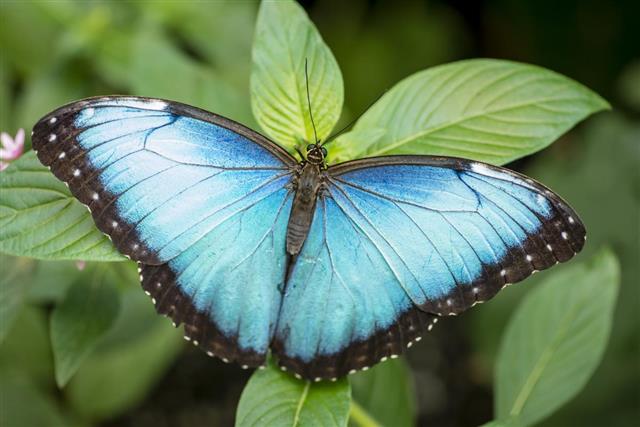
The canopy layer of the rainforest is the primary layer that forms a roof over the understory layer and the forest floor. Many animals and birds live in this maze of leaves and branches. This article will make you aware of the various flora and fauna of the canopy layer.
The forests that grow in regions receiving high rainfall are known as rainforests. The rainforests between the Tropic of Cancer and the Tropic of Capricorn are known as tropical rainforests. They are also found in Asia, Africa, Northern Australia, South America and other tropical regions. The climate near the equator is always hot and wet throughout the year, thus the trees never stop growing and are known as evergreen trees.
The regions further away from the equator have a temperate climate with specific wet and dry season. The trees in this region shed their leaves during the dry spell. Thus, Central America and India have deciduous rainforests. The forest that cover the mountain tops are known as cloud forests. They are so named as they are always covered by the clouds. These trees survive in extremely cold and wet climates.
The Tropical Rainforests
Throughout the year, the tropical rainforests experience high temperatures averaging 25° C. It receive an annual rainfall of about 2 meters and have 100% humidity. Few tropical rainforests receive rainfall up to 10 meters! The largest rainforest in the world is the Amazon rainforest of South America. The Amazon rainforest spans in eight countries, covering a total area of approximately 2 million square miles.
It is interesting to note that rainforests cover only 2% of the world’s land surface and is home to over 50% of the Earth’s animal and plant population. The rainforest canopy layer is divided into four parts. The four layers of the canopy layer are:
- The Emergent Layer: The tallest trees of up to 70 meters height are found in this layer. This layer receives the maximum sunlight and is a safe heaven for small animals and birds, this layer also protects them from predators.
- Canopy Layer: This layer is abundant with food. These trees act as buffers for the smaller trees which are covered with climbers and flowering plants called epiphytes.
- Understory Layer: This layer is dark and almost impenetrable natural habitat. Many nocturnal species make their homes in the understory layer. The trees in this layer reach an average height of 12 to 15 feet.
- Forest Floor: The forest floor is the darkest area as almost no sunlight reaches this area. The soil quality is extremely poor and very few plants grow here. The soil is rich in microorganisms that carry out the natural decomposition of the organic matter.
The canopy layer is home to about 70-90% of the life present in the rainforest. The branches of the trees in the canopy layer look interlocked with each other when observed from an airplane. In reality, the branches do not even touch each other and the trees grow at least a few feet away from each other.
Animals Found in the Canopy Layer of the Rainforest
Many animal species live in the canopy layer as it is rich in fruits and seeds. Monkeys, sloths, bats, tree frogs, ants, beetles, parrots, hummingbirds and snakes are some of the many species that are found in the canopy layer.
The Toucan is one of the many exotic birds of the tropical rainforests found in the canopy layer. There are about 40 different species of the noisy Toucan. The colorful, sharp bill of the Toucan is used to squash the fruits and berries. They even use it to kill and eat small lizards and birds. This bird is found in the canopy layer of the rainforest in South and Central America. These bright, noisy birds are very important to the rainforest canopy layer as they disperse seeds from fruits and berries throughout the forest.
Poison arrow frogs are found in the canopy layer of South and Central America. The poison of these bright-colored frogs can cause paralysis and even death. The poison of one frog can kill about 100 grown people. These frogs are about the size of a man’s thumbnail. Hunters dip their arrow heads in the poison of the frogs giving rise to its unusual name.
The socially compatible and intelligent macaws are native to the rainforest canopy layer of the Central and South America. There are about 16 species of these beautiful birds. Excessive deforestation and the greed of owning these exotic animals as pets have made the birds enter the list of endangered species list.
Spider monkeys are found high in the canopy layer. They eat fruits, seeds and plants. The spider monkeys have four fingers and no thumb! They love to hang upside down with their four limbs and the tail holding the branches. This makes them look like spiders, thus giving them the name. Spider monkeys are on the list of endangered rainforest animals due to excessive hunting.
Sloths are nocturnal animals that can live up to 30 years. They are extremely slow-moving mammals found in the canopy layer. They need very little food due to their slow metabolism rate. These animals rarely climb down the trees and tiny algae grow all over their coat!
The other tropical rainforests animals found in the canopy layer are tree snails, morpho butterfly, boa constrictor, rhinoceros beetle, jaguars and leopards.
Plants Found in the Canopy Layer of the Rainforest
There are many species of flowers found in the canopy layer of the rainforest which result in cross-pollination. Lianas are vines with thick woody stems that grow abundantly in the canopy layer. These vines climb trees to try to reach the sunlight. Some of the lianas include rattan palms, philodendron and Strychnos toxifera. The Asian lianas are used to make baskets, ropes and wicker furniture. The lianas form a network of vines by wrapping themselves on the trees. This provides support to the shallow-rooted and top-heavy trees against the strong winds.
Orchids, ferns, mosses, lichens and other epiphytes grow on the trunks where sunlight is the maximum. Epiphytes also known as air plants also grow in the rainforest canopy layer. They grow on branches, trunks and even rocks. Trees support the epiphytes by providing them with rainwater. Many epiphytes are self-sustaining, that is, they prepare their own food with the help of sunlight and air.
The beauty of the canopy layer is enhanced by the brightly colored flowers growing on the epiphytes. Orchids and bromeliads are some of the variety of epiphytes growing in the canopy layer of the rainforest. Bromeliads have thick, waxy leaves, which form a bowl shape to catch rainwater. Some are so large that they can hold several gallons of water. Many tadpoles, salamanders, snails and beetles grow in these leaves forming a mini ecosystem.
The ‘killer tree’ or the ‘stranglers’ of the fig family grow as an epiphyte high in the trees. The monkeys and birds eat the fig fruit and throw the seeds on the tree branches. The plant begins to grow and sends down long roots to the ground. Once the roots reach the ground, the fig grows quickly, suffocating the host tree. In the end a large dead tree with a hollow core stands upright surrounded by a strangler.
‘If there is land, there is man!’. Well humans have lived in the thick, inhospitable areas of the rainforest. Although, they do not live in the canopy areas of the rainforest, they should be mentioned. The pygmies of Central Africa, the Huli tribe of Papua New Guinea, the Yanomami of South America are few of the many tribal populations found in the rainforests all over the world.
Preserving the Rainforests
The rainforest provide man with abundant natural wealth. However, around 6000 acres of rainforest is disappearing per hour due to deforestation. Many species of plants and animals are wiped out from the face of the earth as their natural habitat is destroyed. Losing even one plant or animal results in disruption and damages the entire ecosystem. The vast rainforest still has many species of flora and fauna that are yet to be discovered.
Destruction of the rainforest may result in losing these unknown species forever. Man’s indifferent nature regarding pollution and stripping the rainforest of its natural wealth for personal greed has resulted in extinction of an average of 140 species per day. If this apathetic activity is carried on without check, half of the plant and animal species of our planet will be obliterated.
The governments and people should act and do everything possible to save the fast disappearing forests. We should learn from the indigenous groups living in the rainforests about ways of reaping benefits from nature’s bounty without destroying it. Lumber companies should replace every tree cut with a new sapling to replenish what is lost.
As the most intelligent and highly evolved species on planet earth, let’s do our bit in saving other species down the line of evolution.















